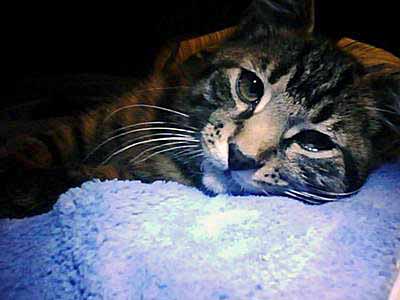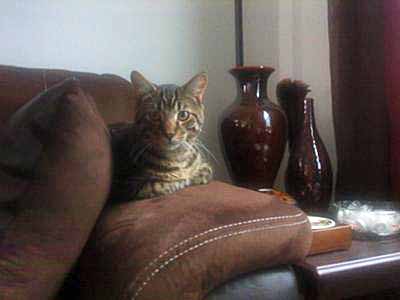
The Bengal cat we hear about is a Bengal House cat or domesticated pet. This is currently an introductory page (things change and evolve on the internet!). You can see and read about a lot more on this page:
Please click here to see visitors’ submissions that have been made using an input form at the base of the page.
The following link goes to a large number of submissions on this breed on an associated page
This link takes you to a collage of photos all by Helmi Flick of Bengal cat LOBO plus a bit of info.
And this page takes you to a neighbour of mine, F3 Bengal cat Daniel. He is a pet, a cat companion, not a show cat. But wow! what a cat: Meet Daniel.
The Bengal cat has the typical nature of a pet cat, with a little bit extra in the tank. The first breeding program was carried out by crossing the Asian Leopard Cat (ALC) with domestic the cat breeds Egyptian Maus, Abyssinians or Ocicats. It should be noted, incidentally, that in the 1911 Encyclopedia Britannica it was argued that domestic cats have some ALC in them already as a result of the natural mating between the ALC and a domestic cat possibly a Chinese domestic cat.
If an ALC mates with say an Abyssinian, the offspring are called F1s. The F1 is then crossed with another domestic cat, these days a Bengal cat. That mating results in an F2. The F2 then mates with another domestic cat to produce an F3. The F4 is produced in the same manner and is called a SBT(stud book tradition). Only SBT’s can be shown in championship competition. They are domestic cats containing it is believed about 12.5% of ALC in their genetic make up. F1-F3 are called foundation cats or filials. The F4 is accepted for showing a competition by most international and domestic associations including TICA, ACFA, GCCF, and AACE.

Asian lepoard cat
Because development of this breed is now fairly advanced ensuring adequately sound bloodlines, any further out crossing (breeding to a breed other than another Bengal cat) would be to an ALC (above) to avoid introducing undesirable genes from other breeds and maintain the Bengal breed qualities. Remember some breeds have a propensity for certain conditions and diseases. Currently it seems that the Bengal cat is free of any unwanted conditions (update: this is not true, see this).
At the F1 to F3 mating stages it is usual for a female Bengal hybrid to mate with a male domestic as the male F1 is usually sterile and the F2-3 have fertility problems. There seems to be a desire by some people to adopt an F1-F3. Cats at this stage in development are semi-wild and are not suited for the average family. Breeding “backwards” (towards wild cat): an F4 bred back to a wild cat results in an F1 hybrid (not in an F5) because there is a purebred wild ancestor in the parent generation.
Beyond the Bengal the Cheetoh is a hybrid cat derived by crossing Ocicat and Bengal, to get another breed of spotted cats. The coat is the most striking characteristic of this cat. In the wild the coat is lighter in the cooler regions. The background color varies from blue grey to dark brown. Helmi’s pictures demonstrate the coat colors perfectly.
The Asian leopard cat is similar in size to the Bengal House cat. Their weight is from 10-15 lbs. Their hind legs are longer than average. They are good climbers and live near water in jungles. You can see some of these characteristics coming through in the Bengal cat. For example, Bengals like water, are athletic and quick runners.

The Bengal is a newish breed and has rapidly gained in popularity. This cat’s leopard like appearance being the main reason I suggest. Registrations with the registries, the most prominent of which is The International Cat Association are currently in the order of 60,000 (Sept. 2007 – 41,500 at 2002).
Without the intervention of breeders the development would not have happened (i.e. through natural mating between wild and domestic cat). This is because F1 males (first generation) are sterile and the F1 females are poor mothers. F2s are fertile however.
Breeders produce Bengal House Cats (meaning house cat temperaments). Pedigree records on all registered Bengals are kept by the TICA. Some registries don’t allow registration due to the wild bloodline.
When dealing with a breeder, check these things to ensure all is well, when buying a Bengal house cat:
- there is a contract
- there is a health guarantee
- a term of the contract states that the breeder will accept the return of the cat is the purchaser is unable to care for the cat
- the contract deals with altering (spaying/neutering)
- The contract deals with homing conditions including whether the cat is to be kept indoors or not, or there is an understanding on this.
- the breeder answers questions openly and is prepared to provide instruction where appropriate
- the breeder ideally should be informed by the buyer as to how the cat is progressing regarding health and behavior
- the cattery should be clean and organised and well managed
- the breeder emphasises temperament, character, health as well as appearance
Finally, if you can’t cope with managing your Bengal house cat then contact a Bengal cat club or rescue center rather than give the cat away to someone you are not sure about or a breeder you are not sure about.
See the above video in larger format and two large format stills and some words on the difference between the Bengal house cat and the milder less active Exotic Shorthair cat.
Update Nov. 2010…from Amanda Teeter, Pennsylvania, USA
Tiger, my mischievous, chewing, water loving, active Bengal!!!


I got Tiger when he was 8 weeks old. He is such a spoiled cat, he is my baby. He sleeps with me every night and follows me everywhere. He got into the bathtub with me twice! He loves to chew my cell phone cords and my Elle and Glamour magazines while I watch QVC lol.
He knows when its time for treats 🙂 He is such a joy in my life 🙂
What Other Visitors Have Said
Click below to see contributions from other visitors to this page…
I feel my Bengal cat has become distanced from me I had this beautiful little thing wander up and start wrapping himself around my feet. I did not know what I was getting into when he came up!
I had …
What is the difference between the Bengal cat and the Savannah cat? I have just been asked by a visitor to my YouTube channel for information about the differences in appearance, use of litter, activity levels and liking …
My Story My name is Chloe. I am a lovable Siamese White Bengal. I am in a very loving home with three other kitties. I am 6 years old and just love playing. I am …
Wildcat Parents of Domestic Cats Of the wildcat parents of domestic cats, the Asian Leopard cat (ALC) is not one of the most suitable. I decided this having read a article by a person …
Chhattishgarh Cat ( billu ) Billu is Chhattishgarh cat – he belongs to half leopard family..
Yogendra
Hi Yogendra… nice to hear from India. But I would like you to …
Sources:
- http://www.bengalcat.co.uk/
- http://www.exoticbengals.com/
- Bengal Cats – A complete Pet Owner’s Manual
